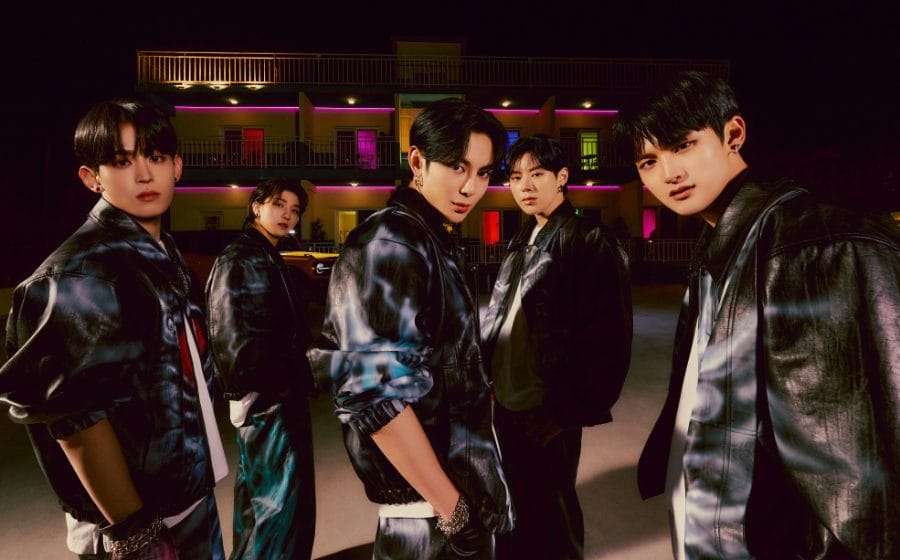 As the title (also the moniker of documentary storyteller OKJ’s latest work) suggests, the emotions one gets from hearing music are dependent on his own imagination — in the documentary’s case, it is one of sheer positivity and joy.
As the title (also the moniker of documentary storyteller OKJ’s latest work) suggests, the emotions one gets from hearing music are dependent on his own imagination — in the documentary’s case, it is one of sheer positivity and joy.
Hello OKJ, thank you again for allowing me a first screening of “A Feeling Of Music Playing”. I understand that it came from a place where you want to “meet in the middle” with musicians and people curious about music. What do you think the sweet spot is?
I believe that life has its rhymes — we use analogies of experiences to describe what we are unable to with words. That is the space I wanted to explore.
For “A Feeling Of Music Playing”, my learning journey while researching for the film led me to a hypothesis that the feelings musicians experience when playing music come from the same source of happiness that kids feel when playing games at a playground. That is the sweet spot in this context.
In your opinion, what are you doing with “My Invisible Life”? What do you think you bring to the table and how does a creative dialogue between creatives work for you?
This film is unique for me in terms of casting. Usually, for my independent works, my documentary subjects had already been cast as the protagonist, which inspired me to embark on a documentary of their life — such as “Galactic Paint”. As for commissioned works, a cast is often already in mind before I come on board the project.
“A Feeling Of Music Playing” was a mix of the two. I met Jeffrey (the host of the documentary) in January 2021 after being introduced by a friend to visit his shop — as I wanted to explore the world of Chinese orchestras — to one day producing a documentary that would be interesting to my wife, who was a pipa player in secondary school.
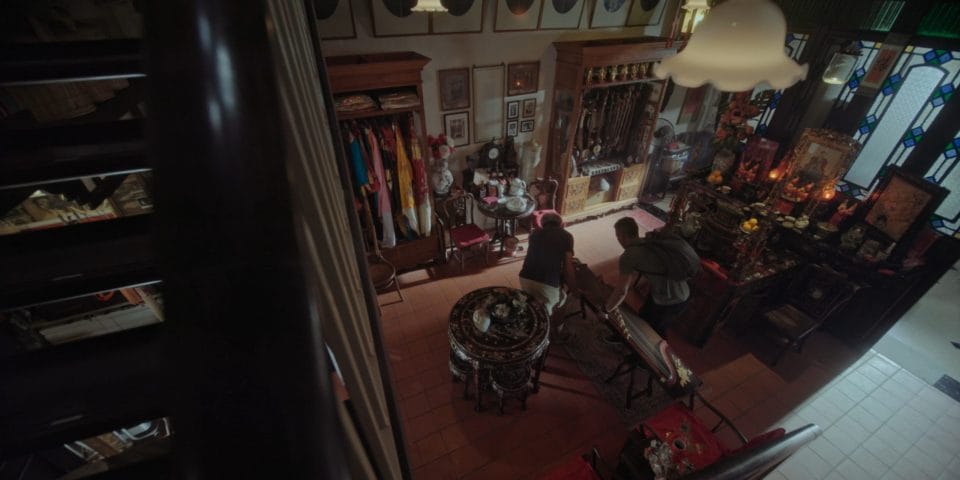 Our initial conversation went well and when I visited him again a few days later to continue the conversation, Jeffrey introduced me to Faizal (the guzheng player) that very day. Jeffrey and his shop have this alluring potential to cultivate new relationships. From that faithful day, I began my first few steps into making a film that eventually became “A Feeling Of Music Playing”.
Our initial conversation went well and when I visited him again a few days later to continue the conversation, Jeffrey introduced me to Faizal (the guzheng player) that very day. Jeffrey and his shop have this alluring potential to cultivate new relationships. From that faithful day, I began my first few steps into making a film that eventually became “A Feeling Of Music Playing”.
The casting of Govin (the tabla player), Wei Jie (the dizi player) and Gildon (the pipa player) was thanks to my producer, Xuan Kai who is a cellist in a Chinese orchestra. By this point, I was determined that this documentary would seek to capture lightning in a bottle — that being to cinematically record the magic of an unscripted jam session and the emotions derived from it.
I was adamant not to script this aspect as it would never feel the same without the spontaneity of this activity and the attempt to do so would also dilute the film’s claim as a documentary.
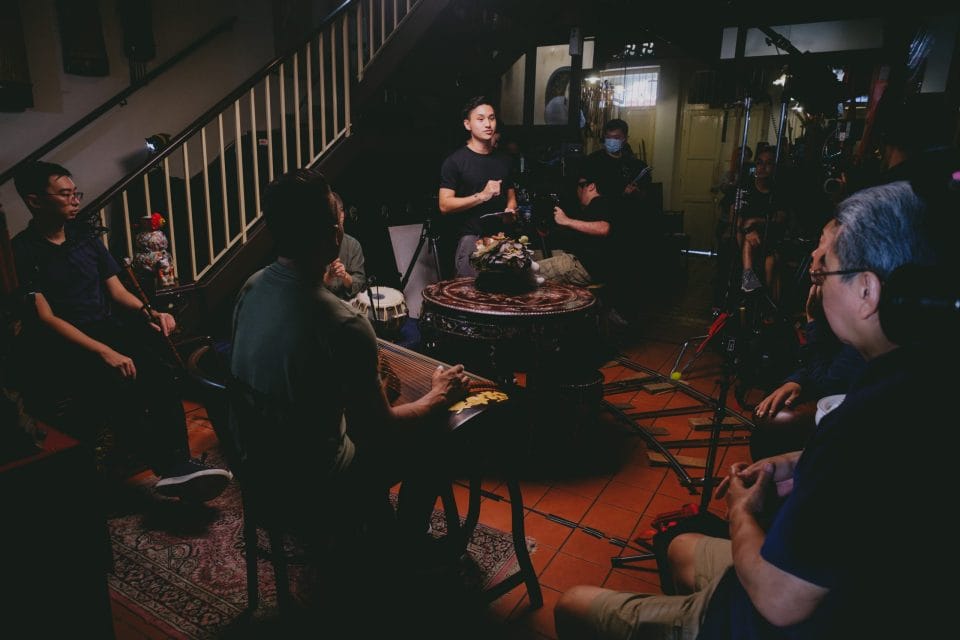 Therefore, Xuan Kai set a few parameters to maximise our chances. Govin, Wei Jie and Gildon do not know of Jeffrey, neither had they visited his shop. Their relationship with Faizal varied in time, and most importantly, the four of them had never jammed together before. However, each of them is an open-hearted, skilled musician, which successfully allowed us to capture the euphoric emotions of a jam session in a single attempt. As with all group activities, its potential is ultimately based on the people involved. We approached the casting process with that in mind.
Therefore, Xuan Kai set a few parameters to maximise our chances. Govin, Wei Jie and Gildon do not know of Jeffrey, neither had they visited his shop. Their relationship with Faizal varied in time, and most importantly, the four of them had never jammed together before. However, each of them is an open-hearted, skilled musician, which successfully allowed us to capture the euphoric emotions of a jam session in a single attempt. As with all group activities, its potential is ultimately based on the people involved. We approached the casting process with that in mind.
I would like to point out that Gildon had only joined the cast the night before filming and was introduced by Govin after he mentioned what we were doing that Labour Day weekend. As this is a phenomenon that happens in real life, we were happy to have Gildon onboard and adapted our set-up accordingly. I cannot imagine what the film would be like without him now.
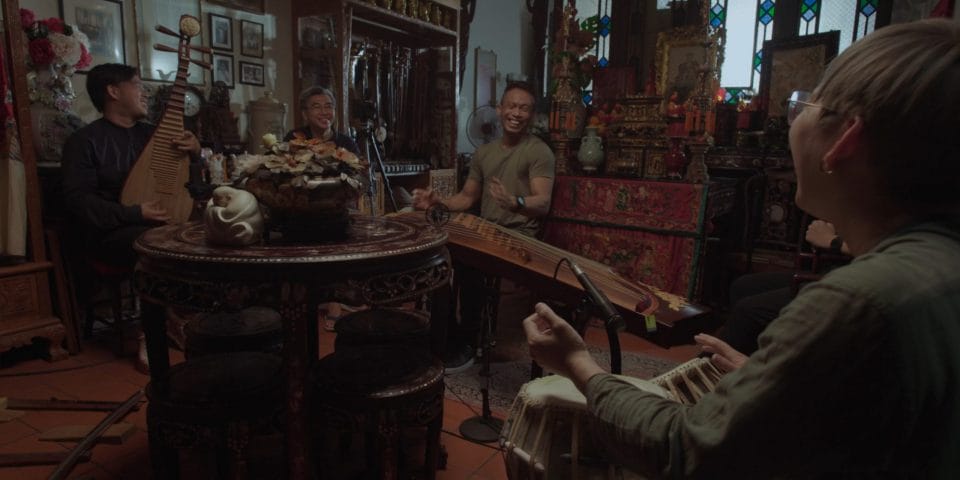 Do you think this unfamiliarity between them created some kind of magic on set? My point of view is that music does unite people after all because — as a former musician myself — we are all trained to appreciate all of its forms.
Do you think this unfamiliarity between them created some kind of magic on set? My point of view is that music does unite people after all because — as a former musician myself — we are all trained to appreciate all of its forms.
I was certain that the casting had to allow magic to occur between unfamiliar individuals. The two people that come to mind are Wei Jie and Jeffrey, each representing music participation on two ends of a spectrum — a trained professional and an amateur at best, respectively.
The audience can witness the magic of these two individuals as well — when Wei Jie spontaneously executed a unique method in playing his dizi and also when Jeffrey took out the bells to chime in. My team — who worked on post-production — told me that given how well all five subjects gelled in the session, it might be easy to mistake the music we enjoyed in the film as pre-planned.
We were lucky to experience the beauty of music jamming and I was happy at the end of the session to know that we had succeeded in recording something so magical.
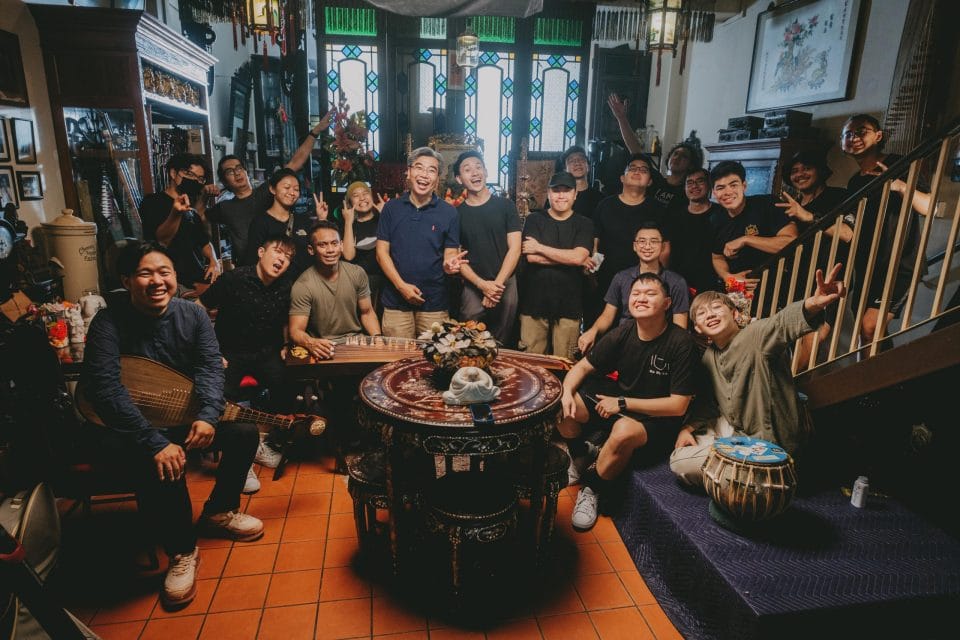 While watching the film, I noticed it felt voyeuristic because of the intimacy in the way it is shot and the cast completely ignores the camera.
While watching the film, I noticed it felt voyeuristic because of the intimacy in the way it is shot and the cast completely ignores the camera.
My working process involves researching past works about the subject, so that I can learn from them and see how my works can add value to the public discourse on the subject.
I went to a couple of music sessions during the research process. As someone who does not go for such experiences before embarking on this project, these new information allowed me to make the creative decisions where I needed to translate the feelings of reality through the medium of documentary. Through this process — together with my producer, Xuan Kai and Director of Photography, Jeremy — we decided to create this “seat” for the audience to experience what would unfold in the film as though they were on location.
It certainly wouldn’t replace the experience of physically being present in such musical sessions; I hope that providing the next best thing will evoke a yearning for the film’s audience to experience it for themselves.
In your 18 months of listening and learning about music, how diverse was your research and what drew you to having Jeffrey “host” the documentary? It is also interesting that he is the “conduit” for the musicians but takes on a passive role; there’s a push and pull to what he does in a very subtle way.
This whole journey started when I was first introduced to Jeffrey, who then introduced me to his world as well as the other musicians’ lives. I then sought out the musical experiences that Jeffrey recommended. Faizal and my other friends who have music in their lives also provided recommendations. I had never been to Esplanade so many times before this project.
I often compare my storyboarding process to dreaming. However, my mind can only use past experiences, so it was imperative to the process that I experienced music to dream about it. I went to free concerts at the Esplanade and had one-on-one introductory sessions to the instruments of each cast except for Gildon. Xuan Kai allowed me to have a go on his cello too!
 Through these experiences, I concluded that the film would translate a feeling of music playing in three structures — through the self, group and space. The aspect of the “space” was one that I felt was underplayed during my research. It is an aspect as equally essential to the musicians themselves to the experience the audience would have. The definition of a conducive space would not necessarily be found in the grandeur. I experienced and learned through third- party anecdotes how seemingly ragged rooms are more welcoming than grand venues.
Through these experiences, I concluded that the film would translate a feeling of music playing in three structures — through the self, group and space. The aspect of the “space” was one that I felt was underplayed during my research. It is an aspect as equally essential to the musicians themselves to the experience the audience would have. The definition of a conducive space would not necessarily be found in the grandeur. I experienced and learned through third- party anecdotes how seemingly ragged rooms are more welcoming than grand venues.
I hypothesised that this is because people make spaces and its human host cultivates the environment that musicians feel before, during and after playing music.
After the film, we discussed that most of its viewers who are not musicians could relate to Faizal the most because he expresses what they are thinking. What do you think are the roles of Gildon, Govin and Weijie then?
I think Gildon gifted us with his ability to describe music in the most accessible terms. This film is ultimately for people like me who do not have the prerequisite knowledge to appreciate music in its entirety. For instance, I do not even know what chords are. Yet, when challenged with this limitation during my interview to gather soundbites, Gildon found the right words that allow the widest array of audiences to fundamentally understand music while also doing justice to the subject matter when audiences of greater experiences watch the film.
Govin gifted us with his expressions. He is a person that truly loves music and lives for it. I can’t do justice to that fact by simply having him explain it, so I am grateful that my crew, the cast and the space that Jeffrey had cultivated allowed him to be himself. His joy exudes from the screen and I hope the audience who watches our film will feel the same.
Finally, Wei Jie gifted us with his interpretation of how he would participate in a free jam session. My editor and subsequently, the audio post-production team enlightened me that Wei Jie was effectively freestyling while keeping in tandem with the rest of the group. It was akin to riffing on a guitar — something that became obvious when he played his dizi in a truly unique manner during the first jam piece.
This allows audience members to identify what “magic” in a jam session could be and also creates value during rewatches.
I am still personally learning from the film through conversations with people who watched it for the first time and I am grateful to the film’s cast, who collectively sparked such conversations.
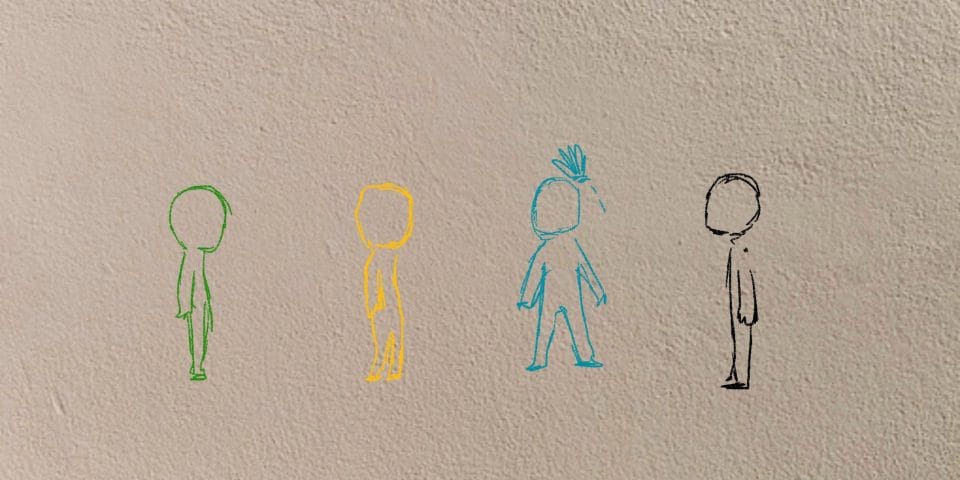 Why did you make the creative choice to have animations inserted as the musicians started jamming? Do you think you are trying to manifest a visual for the audience unfamiliar with music?
Why did you make the creative choice to have animations inserted as the musicians started jamming? Do you think you are trying to manifest a visual for the audience unfamiliar with music?
During my research process, I realised that as an audience member who was witnessing new musical experiences, a common action I would do was to close my eyes in hopes that I could experience the music more. Perhaps I was trying to heighten my sense of hearing by turning off my sense of sight.
Yet, in a medium such as a documentary, what fills the void if the vision of reality is turned off? That question was the hardest to answer and was the final hurdle before I could begin the filming process. The answer literally came when I was staring at the wall of my house one day.
My parents allowed my siblings and me to draw on a section of our house’s wall during my childhood. Once it was filled, we would paint it white and draw again — literally anything to our imagination. It was our space for play.
With this blank canvas, I enabled the film to present my hypothesis — that a feeling of music playing comes from the same source as the feeling of playing without breaking the immersion; the audience would be experiencing the music of the moment. I chose to present childhood playground activities to strengthen this hypothesis.
However, as no verbal explanations are made about them, the rest is up to the audience’s imagination to interpret for themselves.
From my perspective, this “indescribable feeling” you mention is joy — because at the heart of “A Feeling Of Music Playing”, it is always nice seeing people have a good time doing what they enjoy the most.
And I am happy to feel that way! This was exactly the reason why I chose to use playground activities to represent visual imagination. When you hear kids playing with unbridled laughter, it’s contagious. I see musicians having that same expression as well.
A further expansion of my hypothesis is that “A Feeling Of Music Playing” is the joy people feel when achieving a common goal through the participation of unstructured group play. And participating comes in different forms, including being an audience. I am glad that you experienced what you did — that is the film’s namesake.
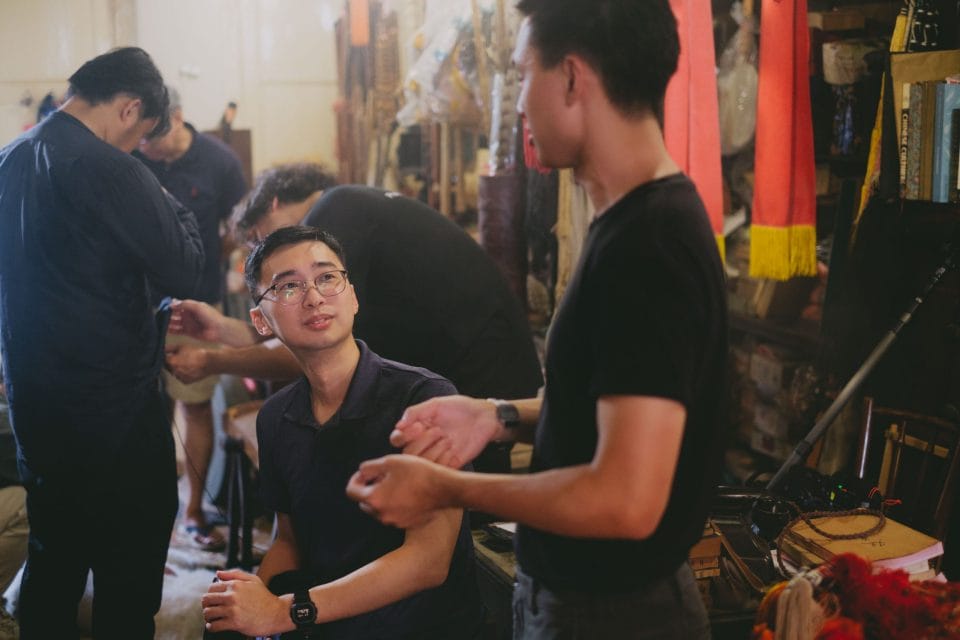
You mentioned, “In my journey to communicate, there was a realisation that there are others like me who wish to be understood”. How do you think your films — particularly your way of doing it — help your subjects verbalise themselves?
I wouldn’t say verbalise, but certainly express themselves in a manner to be understood. That is why we yearn to do that right? To express ourselves in hopes that the people around us we love and care about can understand and subsequently empathise with our experiences and worldview, but there are many barriers to achieving that.
Perhaps it is our lack of confidence, vocabulary or opportunity. That is why I believe documentaries are magical. It is the closest thing I can think of to inserting an HDMI cable in our own minds to express our own stories that we could never do so in other forms. To achieve this, I have deep conversations with my documentary subjects and I listen in order to ask the right questions — questions that my subjects may have never asked themselves and yet could answer honestly as it is their own lived stories.
It is an introspective process that is deeply intimate and with their trust in me — evident by their gift of hard-earned wisdom and personal tales — I do all that I can to translate the heart of their stories into a documentary so that others may understand too.
Lastly, what do you wish for “A Feeling Of Music Playing” to do — in an economic and cultural sense?
“A Feeling Of Music Playing” is to me, an act of putting my money where my mouth is. Since 2013, I have been on this journey with the belief that documentaries can do justice to stories by conveying beyond words and pictures.
With respect to my ultimate responsibility — to do justice to my documentary subjects’ stories — I self-funded “A Feeling Of Music Playing” to retain full creative control. I also have the confidence to do so as I believe that the film would be a highly valuable work of public good upon its completion through subsequent engagement with its audience.
Currently, I am organising a nationwide tour of this work and a few of my other documentaries to showcase the result of a yearning to be understood. I hope to find an exclusive presenting patron who would value being associated with a documentary work that captures the magic of music, heritage and play.
I admit that this is a new way to approach the funding of documentary works, but one that I truly believe in — given the work’s value in impacting society. The funds raised from securing an exclusive presenting patron of “A Feeling Of Music Playing” would naturally enable me and the people who make such works possible to continue producing new works of social and cultural significance.
Once you’re done with this story (you can check up with OKJ’s latest happenings here), click here to catch up with our February 2023 issue!

